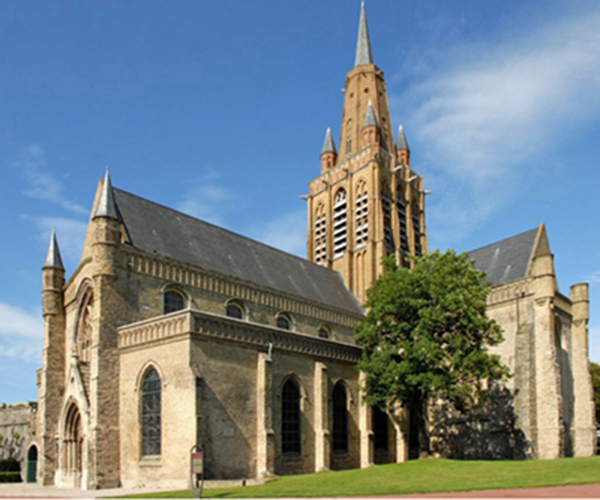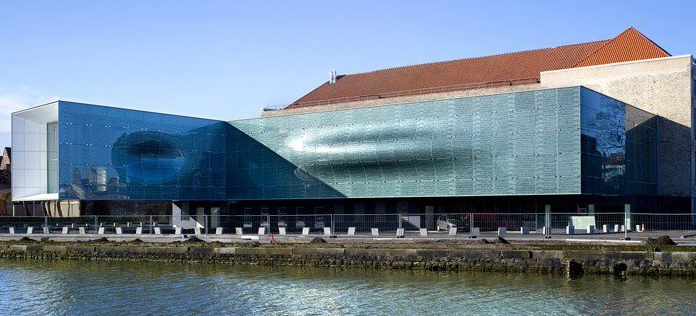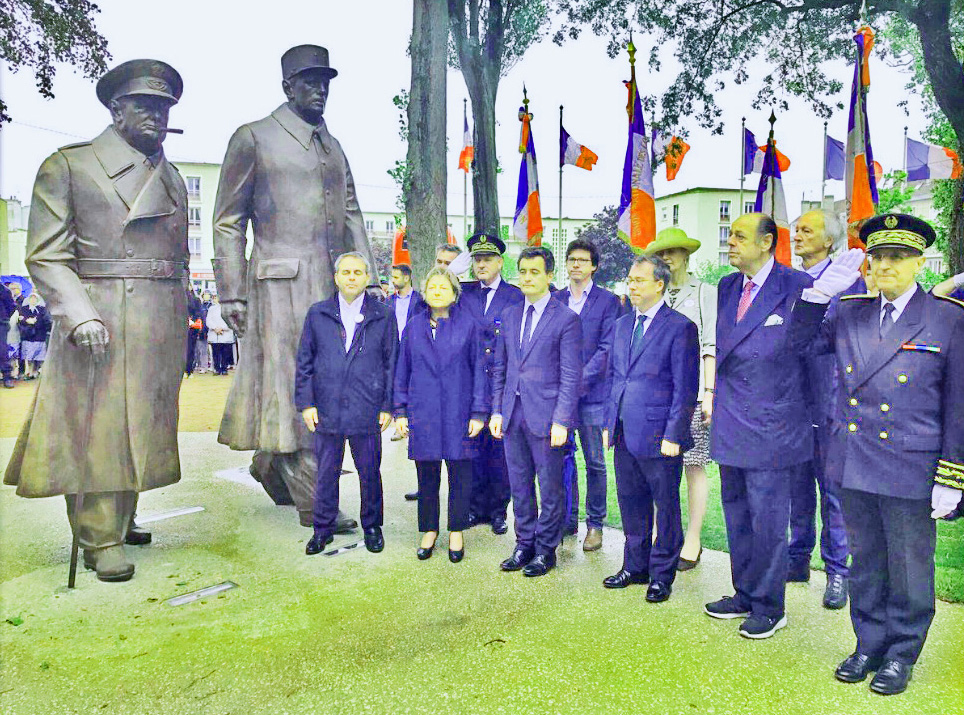






Nottingham by the Sea
1817 - 2017
The 200th Anniversary of the start of mechanical lace making in Calais using a Levers loom smuggled from Nottingham
In
1816 when Nottingham was the world leader in lace manufacturing, three
Nottingham men (Clark, Bonington and Webster) dismantled a Levers loom
and smuggled the parts to Calais, where it was reassembled. In doing so
they risked transportation to Australia, because the movement of
skilled artisans abroad and the exportation of machinery were strictly
forbidden until 1824 and 1843, respectively. Others quickly followed
from all over the East Midlands, bringing their skills and knowhow with
them. So, from this small precarious beginning, a vibrant
Anglo-Calaisian lace manufacturing industry flourished in Calais, which
still exists today, albeit on a much reduced scale.
The English ‘colony’ in Calais once
numbered many thousands, complete with Anglican and Methodist churches,
English schools, cricket clubs, shops, pubs, doctors, undertakers,
performances of Gilbert and Sullivan operas and an English language
newspaper. East Midland lace manufacturing terminology was adopted by
the French, as were the traditions and practices of East Midland lace
workers and factory owners. Calais is the only town in France, where
plum pudding is (still) served on Christmas Day!
All this came to an abrupt end in May 1940,
when the Nazis invaded France. What remained of the English colony in
Calais fled to Great Britain.
This
event was two years in the planning. The main points were to
commemorate the 200th anniversary of the beginning of lace
manufacturing in Calais, to promote interest in the historic links
between Nottingham and Calais, and to build support for a National
Museum of Textiles, Costume and Fashion for Nottingham by giving people
the chance to visit the International Museum of Lace and Fashion in
Calais. About 48 people came from Nottingham and elsewhere in England,
of which 28 were members of the choir.
Renewing the links between Nottingham and Calais
 The performance of English choral music by
the Choir of Saint Mary’s Church Nottingham on 11 November 2017, a symbol of the links between the two cities, was part of the annual musical weekend, Les Rêves de Notre-Dame de Calais
(The Dreams of Our-Lady of Calais) held in Notre-Dame de Calais,
the only church on the Continent built in the English Perpendicular
style. The audience, from both Nottingham and Calais, was in excess of
800 people, more than at any previous concert at this annual weekend
music festival.
The performance of English choral music by
the Choir of Saint Mary’s Church Nottingham on 11 November 2017, a symbol of the links between the two cities, was part of the annual musical weekend, Les Rêves de Notre-Dame de Calais
(The Dreams of Our-Lady of Calais) held in Notre-Dame de Calais,
the only church on the Continent built in the English Perpendicular
style. The audience, from both Nottingham and Calais, was in excess of
800 people, more than at any previous concert at this annual weekend
music festival.
This period of British rule came to an end in 1558 when François de
Guise recaptured the town, causing Mary Tudor of England to famously
utter "When I am dead and opened, you shall find Calais engraved on my
heart."
The church was badly damaged in September
1944 courtesy of the RAF, a few days before the liberation of Calais by
the Canadians, and precious religious artefacts were pillaged. The nave
transept and tower were repaired in 1945 but the interior work remained
unfinished for more than sixty years until work recommenced in 2009.
Most of the restoration work is now complete and the main task
remaining is restoring the organ loft over the west door and replacing
the organ itself. Most of the wood carvings that decorated the organ
loft have been recovered but it is proving difficult to locate a
redundant organ in Britain suitable for this building and location and
the cost of dismantling, transporting, repairing and reassembling a
church organ is a major issue. A small electronic organ will be used on
11 November.
Those responsible for this work are
very conscious of the English heritage and a Tudor garden has recently
been planted round part of the church, designed by the English garden
historian Caroline Holmes of Cambridge. The Peter Beale nursery has
also produced a white rose appropriately named 'Notre-Dame de Calais'
which was exhibited at the Chelsea Flower Show before being
planted in the new garden and offered for sale.
As with all old churches in France,
Notre-Dame belongs to the town and is now being used as a splendid
venue for concerts, conferences and exhibitions.
 Beginning in 1816 when Webster, Clark and
Bonnington smuggled a loom from Nottingham into Calais, Calais became a
centre of lace manufacturing, eventually outgrowing Nottingham. Now
only three or four firms are still making Leavers lace. Dentelle de Calais
® (Calais Lace) is a registered and protected trademark (like Camembert
de Normandie), exclusively reserved for lace made on Leavers
looms by master lacemakers of Calais and Caudry using a unique method
of knotting between the warp and weft, which dates back to the
beginning of the 19th century. Next time you pass through Calais visit the fabulous International Museum of Fashion and Lace.
Beginning in 1816 when Webster, Clark and
Bonnington smuggled a loom from Nottingham into Calais, Calais became a
centre of lace manufacturing, eventually outgrowing Nottingham. Now
only three or four firms are still making Leavers lace. Dentelle de Calais
® (Calais Lace) is a registered and protected trademark (like Camembert
de Normandie), exclusively reserved for lace made on Leavers
looms by master lacemakers of Calais and Caudry using a unique method
of knotting between the warp and weft, which dates back to the
beginning of the 19th century. Next time you pass through Calais visit the fabulous International Museum of Fashion and Lace.
Nottingham has the largest collection of lace in the world but closed its costume museum and moved the collection to Newstead Abbey where it is in permanent storage. The new Lace Hall under construction as part of the Nottingham Castle renewal project could serve as a taster for the National Museum of Textiles, Costume and Fashion in the old Lace Market area of the city.
The
restoration of Notre-Dame de Calais and the campaign to create in
Nottingham an equivalent of the internationally renowned Museum of
Fashion and Lace in Calais are part of an initiative to renew
the historic ties that once existed between Nottingham and Calais. If
you would like to know more about this contact Philip Emerson
Calais
also has an interesting war museum inside the WWII Nazi communications
bunker in the Parc Saint Pierre, opposite the spectacular town hall. And
in June this year the striking statues of the two wartime leaders,
Winston Churchill and Charles de Gaulle, were officially innaugurated
as a symbol of the Anglo-French alliance.

The statues of Churchill and de Gaulle at the entrance to the Park Richelieu were inaugurated on 24 June 2017
Present in the picture are: Patrick
Berthaud the sculptor, Natacha Bouchart (2nd from left) the Mayor of
Calais, Vincent Berton Sub-Prefect for Calais, Pierre Henri Dumont
Member of Parliament for the Pas-de-Calais, Lady Soames, Nicolas Soames
and Lord Llewellyn the British Ambassador.
Credits: Voix du Nord
